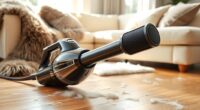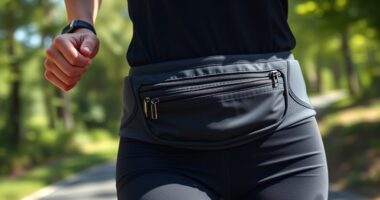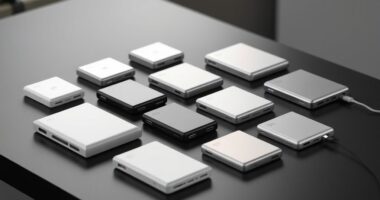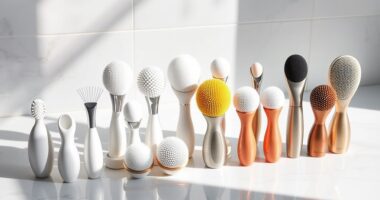If you’re looking for the best 3D printers under $500, I’ve found models that blend affordability with high-quality results. From resin printers like the ANYCUBIC Photon Mono 4 to easy-to-use FDM options like the Creality Ender-3 V3, there’s something for hobbyists and beginners alike. These machines support popular filaments, offer auto-leveling, and provide reliable performance. Keep exploring, and you’ll discover which one fits your project needs perfectly.
Key Takeaways
- Many budget-friendly 3D printers under $500 offer large build volumes, auto bed leveling, and support for multiple filament types.
- FDM printers like Creality Ender 3 V3 and FlashForge Adventurer 5M provide high speeds, reliable quality, and beginner-friendly features.
- Resin printers such as the ANYCUBIC Photon Mono Mono LCD deliver ultra-fine detail and smooth surface finishes at an affordable price.
- Compact, portable models with removable build plates are ideal for small spaces, educational use, and hobbyists on a budget.
- Advanced features like multi-color support, auto filament switching, and Wi-Fi connectivity are increasingly available in affordable 3D printers.
ANYCUBIC Photon Mono 4 Resin 3D Printer

If you’re looking for a high-precision resin 3D printer that’s easy to set up and use, the ANYCUBIC Photon Mono 4 is a top choice under $500. Its 7.10K Mono LCD screen delivers stunning detail with a resolution of 9024×5120, boosting accuracy over previous models. The printer’s 6.04 x 3.42 x 6.49-inch build volume handles detailed projects comfortably. With a stable LighTurbo light source and a laser-engraved Print Platform 2.0, it produces smooth surfaces and reduces warping. The 4-point leveling system simplifies setup, and the resume function saves time after power interruptions, making it perfect for both beginners and experienced users.
Best For: hobbyists, beginners, and professionals seeking high-precision resin 3D printing under $500 with easy setup and reliable performance.
Pros:
- Stunning detail with a 7.10K Mono LCD screen and high resolution of 9024×5120 for ultra-fine prints
- User-friendly 4-point leveling system and resume printing feature simplify setup and operation
- Large build volume of 6.04 x 3.42 x 6.49 inches ideal for detailed models and demanding projects
Cons:
- Does not support the Anycubic APP service, limiting remote management options
- Slightly heavier and larger dimensions, which may require more space for setup
- Limited support or additional features for advanced or industrial use
FLASHFORGE Adventurer 5M 3D Printer

The FlashForge Adventurer 5M stands out for its effortless, one-click automatic printing and seamless bed leveling, making it ideal for beginners and casual users who want reliable results without hassle. Its quick 3-second nozzle change and 35-second warm-up to 200°C streamline setup, saving time and effort. With a CoreXY structure, it reaches speeds up to 600mm/s and accelerates at 20,000mm/s², enabling fast, efficient printing. The dual-fan nozzles, vibration compensation, and multiple nozzle sizes ensure high-quality, precise prints. Plus, remote monitoring via the Flash Maker app adds convenience, making the AD5M a versatile, user-friendly choice under $500.
Best For: beginners and casual users seeking reliable, fast, and easy-to-use 3D printing with minimal setup and maintenance.
Pros:
- One-click automatic bed leveling and quick setup save time and simplify operation
- High-speed CoreXY structure enables rapid printing up to 600mm/s with high precision
- Versatile with multiple nozzle sizes, dual-fan nozzles, and support for diverse filaments
Cons:
- Limited to filament temperatures up to 280°C, which may restrict some advanced materials
- Requires regular maintenance like nozzle and platform cleaning for optimal performance
- Slightly above entry-level price point under $500, which may be a consideration for budget-conscious users
Creality Ender-3 V3 3D Printer

The Creality Ender-3 V3 stands out as an excellent choice for beginners and hobbyists seeking high-speed, reliable 3D printing without breaking the bank. It offers impressive speeds up to 500mm/s with quick acceleration, cutting down print times considerably. The intuitive touch UI screen makes it easy to operate, with real-time model previews for better control. Its high-performance Sprite Direct Extruder and versatile heating system support a wide range of filaments, including PLA, PETG, ABS, TPU, and ASA. The sturdy build and precision components ensure smooth, accurate prints, while automatic leveling and safety features make setup and operation straightforward.
Best For: beginners, hobbyists, and home users seeking high-speed, reliable 3D printing with easy setup and versatile filament support.
Pros:
- Rapid printing speeds up to 500mm/s with high acceleration for reduced wait times
- Intuitive touch UI with real-time model preview enhances user experience
- Supports a wide range of filaments including PLA, PETG, ABS, TPU, and ASA for versatile applications
Cons:
- Assembly can still take some time despite the quick setup, especially for complete beginners
- Higher speed printing may require careful calibration to avoid quality issues
- Limited to a 12-month warranty, which might be shorter than some competitors’ offerings
Creality Ender 3 3D Printer

Designed with beginners and students in mind, the Creality Ender 3 offers an affordable yet reliable 3D printing experience. Its fully open-source design and manageable build volume of 8.66×8.66×9.84 inches make it perfect for learning and experimentation. The printer features several pre-assembled parts, with about two hours needed for full setup. It includes a resume function for power outages, a hot bed heating to 100°C in five minutes, and supports SD card or computer printing. The upgraded extruder reduces clogs, while the V-shape design ensures smooth, quiet operation. Overall, it’s a dependable choice for newcomers seeking quality prints on a budget.
Best For: beginners, students, and hobbyists seeking an affordable, reliable 3D printer for learning and experimentation.
Pros:
- Fully open-source with a manageable build volume, ideal for customization and learning.
- Quick assembly with pre-assembled parts, saving setup time.
- Features like resume printing and fast hot bed heating enhance reliability and convenience.
Cons:
- Limited to SD card and computer connections, no phone-based printing support.
- Requires verification of voltage (115V) to ensure safe operation.
- Slightly limited build volume for larger projects compared to high-end models.
Portable 3D Printer with Removable Build Plate

If you’re looking for a 3D printer that combines portability with ease of use, a model with a removable build plate is an excellent choice. Its compact size (155x175x210mm) and lightweight design make it perfect for small spaces, students, and hobbyists on the go. It supports PLA and TPU filaments, with precise layer control and a build volume of 100x100x100mm. The removable build plate simplifies print removal, while the TF card system and compatibility with popular slicers make operation straightforward. Plus, it comes with a complete starter kit, ensuring you have everything needed to start printing immediately.
Best For: hobbyists, students, and beginners seeking a portable, easy-to-use 3D printer for small projects and educational purposes.
Pros:
- Compact and lightweight design for easy transport and small workspace use
- Removable build plate simplifies print removal and post-processing
- Supports popular filaments like PLA and TPU with precise layer control
Cons:
- Limited build volume of 100x100x100mm may restrict larger projects
- Printing speed of up to 40mm/s may result in longer print times for complex models
- Compatibility mainly with Windows and iOS; may require additional setup for other systems
Creality Ender 5 Max 3D Printer

For anyone seeking a large-format 3D printer that combines speed, stability, and durability, the Creality Ender 5 Max stands out as an excellent choice under $500. It boasts a high-torque XY motor that reaches speeds up to 700 mm/s, making rapid prototyping possible. The dual-gear extruder ensures smooth, clog-free extrusion, even during long prints. Its sizable 400×400×400mm build volume supports both small batches and large projects. The reinforced frame and 36-point auto-leveling system guarantee stability and precision. With a fast-heating aluminum bed and compatible material options, it’s perfect for high-quality, large-scale prints, all managed remotely via Wi-Fi.
Best For: hobbyists and small-scale professional users seeking a large, fast, and reliable 3D printer for intricate and large-format projects under $500.
Pros:
- Rapid printing speeds up to 700 mm/s with high acceleration for efficient prototyping.
- Large 400×400×400mm build volume suitable for diverse project sizes.
- Durable all-metal dual gear extruder ensures smooth, clog-free extrusion during long prints.
Cons:
- High-speed operation may require careful calibration to maintain print quality.
- The large build volume might result in longer print times for sizable models.
- Advanced features like Wi-Fi management may have a learning curve for beginners.
3D Printers Tina2 Basic, Fully Assembled and Auto Leveling 3D Printer

The Tina2 Basic 3D Printer stands out as an excellent choice for beginners and kids thanks to its fully assembled setup and auto-leveling feature, which simplifies the printing process. Its compact size (8.3×8.3×11.4 inches) and lightweight design make it portable and easy to place in various environments like classrooms or bedrooms. With a 100x105x100mm build volume, it handles small to medium projects well. Features like a 2.4-inch LCD screen, Wiibulider slicer software, and offline printing support make it user-friendly. The dual Z-axis rails ensure stable, detailed prints, making it perfect for hobbyists or young learners exploring 3D printing.
Best For: beginners, kids, and hobbyists seeking a compact, easy-to-use 3D printer for small projects and educational purposes.
Pros:
- Fully assembled and auto-leveling design simplifies setup and operation.
- Compact and lightweight, making it highly portable and suitable for small spaces.
- Dual Z-axis rails ensure stable, precise, and detailed prints.
Cons:
- Limited build volume (100x105x100mm), not suitable for large projects.
- Basic features may lack advanced customization options for experienced users.
- Small LCD screen and minimal interface could be less convenient for complex tasks.
Creality Hi Combo 3D Printer

Creality Hi Combo 3D Printer stands out for makers who prioritize multi-color printing and easy support removal, thanks to its innovative CFS technology. It allows up to 16 colors, auto filament switching, and airtight storage, making complex multi-color prints simple. Supports are created from separate, water-soluble or snapped materials, leaving minimal marks. The printer features ultra-smooth motion at speeds up to 500mm/s with precise dual motorized lead screws. Its auto bed leveling and RFID recognition streamline setup and filament detection. With 95% pre-assembly, a foldable touchscreen, webcam, and responsive support, it’s a versatile choice for high-quality, hassle-free printing under $500.
Best For: makers and hobbyists seeking multi-color 3D printing with easy support removal, precise motion, and user-friendly features under $500.
Pros:
- Supports up to 16 colors with auto filament switching and airtight storage for complex multi-color prints.
- High-speed, ultra-smooth motion up to 500mm/s with precise dual motorized lead screws.
- Features auto bed leveling, RFID filament recognition, and a user-friendly foldable touchscreen.
Cons:
- May require some assembly and calibration for optimal performance.
- Limited to Creality RFID filaments for automatic detection.
- Smaller build volume compared to some larger 3D printers.
ELEGOO Neptune 3 Pro 3D Printer with Auto Bed Leveling

If you’re looking for a reliable 3D printer that combines precision with ease of use, the ELEGOO Neptune 3 Pro is a smart choice. It offers an 8.85×8.85×11 inch build volume, perfect for most projects, and comes pre-assembled for quick setup. The dual synchronized lead screws and dual-motor Z-axis drive ensure stable, accurate movements, while the silent stepper motors keep noise levels low. Its direct dual-gear extruder handles various filaments like PLA, TPU, PETG, and ABS smoothly. The auto bed leveling feature scans 36 points on the hotbed, guaranteeing even prints. Overall, it’s a user-friendly, high-precision machine under $500.
Best For: hobbyists and small-scale creators seeking a reliable, easy-to-use 3D printer with high precision and auto bed leveling at an affordable price.
Pros:
- User-friendly setup with pre-assembled components and included toolkit
- Stable and accurate motion system with dual lead screws and dual-motor Z-axis drive
- Quiet operation thanks to silent stepper motors and noise-reducing design
Cons:
- Limited build volume compared to larger industrial printers
- Might require calibration adjustments for optimal print quality over time
- Some users may find the filament compatibility or extruder maintenance slightly complex
3D Printer Enclosure with LED Light

A 3D printer enclosure with LED lighting is an essential upgrade for anyone looking to improve print quality and workspace safety on a budget. It’s compatible with popular models like the Ender3 series and Bambu Lab A1, with dimensions that fit smaller printers—just verify before purchasing. The enclosure maintains stable temperature and humidity, reducing warping and cracking, while the included thermometer and humidity meter let you monitor conditions easily. Its fully enclosed design minimizes dust, noise, and fumes, creating a safer, quieter environment. Plus, the LED lights and transparent window let you watch your prints progress clearly, making troubleshooting straightforward. Assembly is quick, and the durable frame ensures long-term use.
Best For: hobbyists, educators, and small-scale 3D printing enthusiasts seeking to improve print quality, safety, and workspace comfort without high costs.
Pros:
- Maintains stable temperature and humidity to reduce warping and cracking
- Fully enclosed design minimizes dust, noise, and fumes for a safer environment
- Easy to assemble with durable construction and clear visibility for monitoring prints
Cons:
- Compatibility limited to printers within specific size dimensions; larger printers may not fit
- Requires verification of specific printer dimensions before purchase
- May not accommodate all custom or very tall printer setups
Creality Ender 3 V3 SE 3D Printer

Designed for enthusiasts seeking high-quality prints without breaking the bank, the Ender 3 V3 SE offers impressive speed and stability. It supports a maximum printing speed of 250mm/s with 2500mm/s² acceleration, reducing print times by 73% without sacrificing quality. Its upgraded Sprite full metal dual-geared extruder provides strong filament pushing force and smooth feeding for PLA, TPU, PETG, and more. Auto leveling with CR Touch guarantees accurate prints, while dual Z-axis lead screws and steel shafts improve stability. Preassembled and easy to set up in just 20 minutes, it also includes reliable support and a 12-month warranty, making it an excellent choice for budget-conscious creators.
Best For: hobbyists and budget-conscious creators seeking fast, high-quality 3D prints with easy setup and reliable support.
Pros:
- Fast printing speeds of up to 250mm/s significantly reduce production time.
- Automatic leveling with CR Touch ensures precise and consistent prints.
- Preassembled design allows quick setup in just 20 minutes.
Cons:
- May have limited build volume compared to larger printers.
- Requires some familiarity with 3D printing for optimal results.
- Slightly higher noise levels during operation due to high-speed printing.
Creality Resin 3D Printer for Beginners

The Creality HALOT R6 stands out as an excellent choice for beginners, kids, and hobbyists looking to plunge into resin 3D printing without a steep learning curve. Its compact, lightweight design (just 4.25kg) made of durable, impact-resistant alloy makes it easy to handle and position. The 2K 6.08-inch LCD screen simplifies operation, and the built-in guide helps new users start printing right away. Its uniform UV light source guarantees high-quality, detailed models, while features like remote monitoring and user-friendly software make the process straightforward. Overall, the HALOT R6 offers reliable performance and ease of use, perfect for those just getting started with resin printing.
Best For: beginners, kids, and hobbyists seeking an easy-to-use resin 3D printer with high detail and reliable performance.
Pros:
- Compact and lightweight design makes it portable and easy to handle
- User-friendly 2K LCD monochrome screen with built-in guide simplifies operation
- Stable UV light source ensures high-quality, detailed models
Cons:
- Small build plate may limit larger print projects
- Basic slicer software might require alternative options for advanced features
- Handling chemicals like resin and isopropyl alcohol requires safety precautions
Anycubic Kobra 3 Max 3D Printer

If you’re looking to print large-scale projects without breaking the bank, the Anycubic Kobra 3 Max stands out with its massive 420x420x500mm build volume. This allows me to create oversized, detailed models like pet playgrounds or full-scale DIY sand tables in one piece. It supports multicolor printing through connection with Anycubic ACE Pro units, and pairing two units lets me print in up to 8 colors for vibrant results. With high-speed, precise printing speeds up to 600mm/s and smart safety features including AI monitoring, I get fast, accurate prints with peace of mind. Plus, its solid warranty and excellent customer support make it a reliable choice.
Best For: hobbyists, educators, and professionals seeking to print large-scale, multi-color models with high speed and precision.
Pros:
- Massive build volume of 420x420x500mm for oversized projects
- Supports up to 8-color printing with Anycubic ACE Pro units for vibrant, complex designs
- High-speed printing up to 600mm/s with accurate, stable results
Cons:
- Larger size may require significant space and setup considerations
- Multicolor printing setup involves additional units and complexity
- Higher initial cost compared to smaller or single-color 3D printers
Factors to Consider When Choosing 3D Printers Under 500

When choosing a 3D printer under $500, I look closely at printing technology, build volume, and material options to guarantee it fits my project needs. Ease of setup and print quality features are also key factors that make a big difference in my experience. Understanding these points helps me pick a reliable printer that delivers great results without breaking the bank.
Printing Technology Types
Choosing the right 3D printer under $500 depends heavily on understanding the main printing technologies available. FDM printers, which use thermoplastic filaments melted and extruded layer by layer, are popular for their versatility, faster speeds, and larger build volumes. Resin-based printers, utilizing LCD or DLP technology, cure liquid resin with UV light to produce highly detailed models with smooth surfaces, ideal for miniatures or jewelry. SLA printers employ a laser to cure resin selectively, offering superior surface quality and precision. Each technology impacts resolution, material options, and post-processing needs. FDM printers are generally more accessible and faster, while resin-based options excel in detail. Your choice should align with your specific project needs, balancing detail, speed, and ease of use.
Build Volume Size
The size of a 3D printer’s build volume directly impacts what you can create. If you need to print larger models or multiple smaller items at once, look for a printer with a bigger build area, usually specified in millimeters. Keep in mind, larger build volumes often mean a bulkier printer that requires more space. On the other hand, smaller build areas excel at detailed miniatures or quick prototypes, offering higher precision in confined spaces. It’s essential to balance your typical project size with the printer’s maximum build dimensions to ensure it fits your needs and workspace. By choosing a model with an appropriate build volume, you’ll optimize your printing experience and avoid unnecessary limitations or space constraints.
Material Compatibility
Material compatibility is a essential factor to contemplate because not all 3D printers support the same filament types. You need to guarantee the printer can handle the materials you plan to use, like PLA, PETG, ABS, or TPU, for ideal results. Check the maximum extrusion temperature to confirm it can melt your chosen filaments properly. Also, verify if the build plate can support specific materials—heated beds are necessary for ABS, and flexible filaments may require special support. Consider whether the firmware allows easy switching between filaments without extensive recalibration. Keep in mind that some budget models may have limited compatibility with specialty materials, so confirming support before purchasing is key for achieving high-quality, versatile prints.
Ease of Setup
When selecting a 3D printer under $500, ease of setup should be a top priority, especially if you’re new to 3D printing. Look for models with automatic bed leveling and pre-assembled parts to reduce technical adjustments. Opt for printers that feature straightforward calibration procedures, such as auto-calibration sensors or guided leveling systems, which make initial setup easier. Choose units that require minimal assembly—ideally, fully assembled or with just a few simple steps before printing. Quick warm-up times and rapid filament loading also help streamline the process, saving you time and frustration. finally, check user reviews to find models praised for straightforward setup and minimal troubleshooting, ensuring your first experience is smooth and hassle-free.
Print Quality Features
Choosing a 3D printer under $500 isn’t just about affordability; it also depends on the quality of the prints it produces. High-resolution LCD or monochrome screens are vital for detailed, smooth surface finishes. Look for printers that support a layer resolution of 0.02mm or better—this guarantees fine detail and crisp edges. Features like uniform light sources and advanced masking help achieve consistent curing, reducing layer lines and improving overall surface quality. Supporting ultra-fine layer heights directly impacts surface smoothness and detail accuracy. Additionally, stable mechanical components and precise Z-axis movement are essential for maintaining consistent layer alignment. These elements work together to deliver high-quality prints, making sure your investment results in detailed, professional-looking models.
Support and Warranty
A solid support and warranty plan can make all the difference when selecting a 3D printer under $500, as it guarantees you’re covered if anything goes wrong. I look for a warranty of at least 12 months to guarantee protection against manufacturing defects and technical issues. Reliable customer support, available through email, phone, or live chat, is vital for troubleshooting and guidance when needed. I also check if the manufacturer offers resources like FAQs, user communities, or dedicated technical help, which can save time and frustration. Additionally, a warranty that covers replacement parts and shipping costs provides extra peace of mind, especially for long-term use. Having dependable support means I can focus on creating without worrying about unexpected repairs or technical setbacks.
Price and Value
Price and value are key factors I consider after ensuring a 3D printer has solid support and warranty coverage. With models under $500, I look for a good balance of affordability and essential features like auto-leveling and reliable extrusion, which make printing easier for beginners. Many budget printers offer decent resolution, around 0.1 to 0.3mm layer thickness, providing acceptable detail for most projects. I also prioritize versatility, such as compatibility with materials like PLA, PETG, and TPU, to maximize value. Features like auto filament loading, resume printing, and simple assembly add convenience without extra cost. Choosing a well-reviewed printer guarantees I get a reliable mix of quality, durability, and features, making it a smarter investment in the long run.
Frequently Asked Questions
What Is the Typical Print Resolution for Under-$500 3D Printers?
Most under-$500 3D printers offer a print resolution of around 100 to 200 microns, which balances quality and speed nicely. I’ve found that this range produces detailed prints suitable for prototyping and hobby projects. While you might get slightly better resolution with pricier models, these affordable options still deliver impressive results for their price. Keep in mind, tweaking settings can improve quality even further.
How Long Does It Usually Take to Assemble These Budget Models?
When I built my budget 3D printer, it took about 2 to 4 hours to assemble, depending on experience. For example, a friend with no prior experience finished his in roughly three hours, following step-by-step instructions. These models usually come partially assembled, making setup straightforward. I recommend dedicating extra time for calibration to guarantee high-quality prints, but overall, most under-$500 printers are designed for quick, manageable assembly.
Are There Any Common Maintenance Issues With Affordable 3D Printers?
Yes, affordable 3D printers often have common maintenance issues. I’ve noticed that bed leveling can be tricky, so I check it regularly. Filament jams and extruder clogs happen sometimes, especially if I don’t keep the machine clean. Lubricating the moving parts and inspecting belts helps prevent problems. Staying on top of these routine tasks keeps my printer running smoothly and guarantees consistent, high-quality prints.
Can These Printers Handle Multiple Filament Types Effectively?
Did you know that over 60% of budget 3D printers can handle multiple filament types? I’ve found that many affordable models are surprisingly versatile, especially those with a heated bed and an all-metal hotend. They can usually manage PLA, ABS, and PETG effectively. Just keep in mind, some cheaper printers may struggle with complex filaments or require fine-tuning, but overall, they’re quite capable for multi-material printing.
What Is the Average Print Size Capacity for Models Under $500?
The average print size capacity for models under $500 typically ranges from 150x150x150mm to 220x220x250mm. I’ve found that most affordable printers offer a decent build volume for hobby projects and small prototypes. While these sizes might limit larger jobs, they’re perfect for everyday printing needs. If you need bigger builds, you might want to look for models with slightly larger dimensions or consider upgrading parts later.
Conclusion
After exploring these top picks, I realize that finding a high-quality 3D printer under $500 isn’t just about the specs—it’s about matching features with your creative goals. Coincidentally, I discovered that the best choice often depends on what you value most, whether it’s resin detail or versatile filament options. No matter which model you pick, I believe you’ll find that affordable doesn’t mean sacrificing quality—you just need to choose the right fit for your journey.









